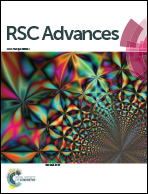Layer-by-layer assembled (high-energy carbon nanotube/conductive carbon nanotube)n nanocomposites for high volumetric capacitance supercapacitor electrodes†
Abstract
We introduce high-performance ultrathin electrochemical electrodes based on multi-stacking of high-energy multiwall carbon nanotube (MWCNT) hybrids and conductive MWCNTs. The MWCNT hybrids coated with oleic acid-stabilized pseudocapacitive nanoparticles (i.e., OA-PC–MWCNTs) were assembled via a sequential covalent-bonded layer-by-layer (LbL) approach with amine-functionalized MWCNTs (NH2–MWCNT) in organic media, generating a highly porous structure and allowing for precise nanoscale control of the electrode thickness. The resultant NH2–MWCNT/OA-PC–MWCNT multilayer electrodes exhibited a high energy capacity and remarkable operational stability, considerably higher than the capacity and stability of conventional blended nanocomposite or electrostatic LbL-assembled electrodes. The volumetric capacitances of the (NH2–MWCNT/OA–Fe3O4–MWCNT)20 and (NH2–MWCNT/OA–MnO–MWCNT)20 were approximately 394 ± 10, and 674 ± 13 F cm−3 at 1 A cm−3, respectively. Additionally, these electrodes maintained their high volumetric capacitances without loss of initial capacitance even after 10 000 cycles; this cycling stability stemmed from the formation of chemically stable covalent bonds between the MWCNT hybrids and NH2–MWCNTs and between the PC NPs and NH2–MWCNTs. Given that a variety of PC NPs can be used to prepare MWCNT hybrids and that this approach can be further expanded to nanocomposite films including LbL-assembled multilayers, our approach may provide a promising platform for designing electrodes for use as thin film-type energy storage devices.


 Please wait while we load your content...
Please wait while we load your content...